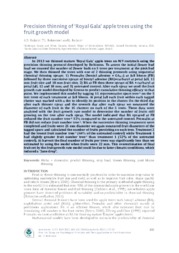Precision thinning of 'Royal Gala' apple trees using the fruit growth model.
Precision thinning of 'Royal Gala' apple trees using the fruit growth model.
Author(s): RUFATO, A. de R.; ROBINSON, T. L.; RUFATO L.
Summary: Abstract In 2013 we thinned mature "Royal Gala" apple trees on M.9 rootstock using the precision thinning protocol developed by Robinson. To assess the initial flower bud load we counted the number of flower buds on 5 trees per treatment at the pink bud stage. We then thinned the trees with one of 2 thinning protocols using sequential chemical thinning sprays: 1) Promalin (benzyl adenine + GA 4+7 ) at full bloom (FB) followed by three successive sprays of benzyl adenine (BA)+carbaryl at petal fall, 12 mm fruit size and 18 mm fruit size; 2) BA at FB then three sprays of BA + carbaryl at petal fall, 12 and 18 mm; and 3) untreated control. After each spray we used the fruit growth rate model developed by Greene to predict cumulative thinning efficacy to that point. We implemented this model by tagging 15 representative spurs tree -1 on the 5 test trees of each treatment at full bloom. At petal fall each fruit within each tagged cluster was marked with a dot to identify its position in the cluster. On the third day after each thinner spray and the seventh day after each spray we measured the diameter of each fruit in the 15 clusters on each of the 5 trees. These data were analyzed with the fruit growth rate model to determine the number of fruits still growing on the tree after each spray. The model indicated that BA sprayed at FB reduced the fruit number tree -1 32% compared to the untreated control. Promalin at FB did not reduce fruit number tree -1 . When the successive thinning treatments were completed and fruits were 25 mm diameter we again measured fruit diameters of the tagged spurs and calculated the number of fruits persisting on each tree. Treatment 2 had the lowest fruit number tree -1 (44% of the untreated control) while Treatment 1 had slightly greater fruit number tree -1 than treatment 1 (52% of the untreated control). At harvest the final number of fruits per trees was significantly less than we estimated by using the model when fruits were 22 mm. This overestimation of final fruit set by the fruit growth rate model could be due to later climatic conditions, which induced a "June drop". Keywords:Malus × domestica, predict thinning, crop load, bloom thinning, post bloom thinning
Publication year: 2017
Types of publication: Journal article
Unit: Embrapa Grape & Wine
Observation
Some of Embrapa's publications are published as ePub files. To read them, use or download one of the following free software options to your computer or mobile device. Android: Google Play Books; IOS: iBooks; Windows and Linux: Calibre.
Access other publications
Access the Agricultural Research Database (BDPA) to consult Embrapa's full library collection and records.
Visit Embrapa Bookstore to purchase books and other publications sold by Embrapa.

